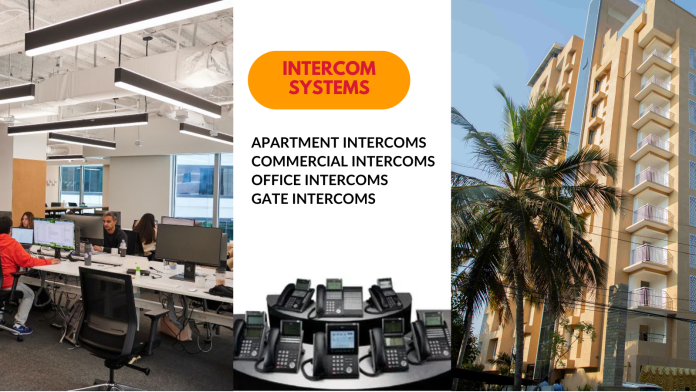For more than a century, intercom systems have been used to not only secure buildings but also to simplify the process of accessing property. At every place, intercoms improve both the safety and convenience of the environment. It is possible for any property that has managed guest access to benefit from an intercom system. This includes industrial facilities, gated communities, apartments, and workplaces.
We explore intercom systems in this post. We will also go through its components, its working system, and different types of Intercom systems. Read on to answer all your building intercom queries.
What Is An Intercom System?
An epabx intercom system is an electrical device that facilitates bidirectional communication between individuals. Intercom systems enable someone within a building to remotely provide property access to visitors by opening a door or gate.
Intercom systems have evolved in various forms over time. Old intercom systems necessitated individuals to communicate through metal tubing, which transmitted their voices similarly to two cans linked by a thread. Modern electronic intercoms nowadays are equipped with circuitry specifically created to digitally broadcast and receive audio and video.
Intercom systems have various applications, but their main function is to facilitate communication and property entry.
Components Of An Intercom System
Modern intercom systems consist of two components:
- A base station
- One or more substations
A base station, or ‘master station,’ is the major component of an intercom system. A property’s doorway has it.
Substations connect the base station. The building has substations in apartments and offices.
Intercom base stations
Intercom system base stations facilitate communication between those outside and within a structure.
The base station serves as the central component of the intercom system, overseeing its operation. The base station, positioned at the property’s entry, requires connections to power, a door release device, and each substation. You can either connect the base station to substations using cables or wirelessly.
Visitors utilize the base station to inform tenants of their arrival and communicate with any substation in the building.
Intercom substations
Intercom system substations enable occupants within a building to speak with others located outside the building. Tenants can also authorize visitors to enter the property by using a ‘door open’ button.
Historically, substations were tangible devices equipped with a speaker and a microphone. Install the sensors at different locations in the building and connect them directly to the base station using hardwiring.
Modern intercom systems now utilize cellphones as the intercom substations, eliminating the need for traditional hardware. This feature enables tenants to remotely unlock the door and view visitors through a live video call.
How Does An Intercom System Work?
An intercom system enables guests to contact renters in a building and subsequently transmits audio and video data to substation devices for communication between tenants and visitors.
The base station records audio and video and sends them to substations. The substations enable tenants to see and verbally communicate with visitors prior to granting them entry into the building. Tenants have the ability to unlock the door or gate from a distance by pressing a button on their gadget.
What Are The Types Of Intercom Systems?
Many intercom systems are available. Others are wired, others wireless, Others are for commercial buildings, while others are for apartments.
Here are the 9 most common types of intercom systems:
- Wireless intercoms
- Wired intercoms
- Audio intercoms
- Video intercoms
- Outdoor intercoms
- Apartment intercoms
- Commercial intercoms
- Office intercoms
- Gate intercoms
Wireless Intercoms: Perfect for homes and offices, wireless intercoms use radio waves to communicate without wiring.
Wired Intercoms: Wired intercoms employ cables for communication and are reliable and stable. They are used in commercial settings because of their reliability.
Audio Intercoms: The usual choice for secure entrances or internal communication, audio intercoms allow voice communication without visible contact.
Video Intercoms: Live video feeds allow users to see and chat with visitors or coworkers before authorizing entry, adding security.
Outdoor Intercoms: Durable outdoor intercoms are used for gates, entrances, and points of access that need exterior communication.
Apartment Intercoms: The Intercom system for housing society improves security and convenience by connecting residents and guests.
Commercial intercoms: Commercial intercoms are sturdy systems for businesses, retail areas, and industrial environments with enhanced functions.
Office Intercoms: Intercom System Installation for office is very important and improves internal communication, supporting efficient collaboration and providing a rapid and secure way to reach coworkers.
Gate Intercoms: Manage gated areas by communicating with people at the entrance and allowing secure passage through gates or obstacles.
Conclusion
In conclusion, intercom systems have protected security and convenience for a century. Their capacity to improve safety and regulate property access makes them invaluable in various locations. From businesses to residences, gated communities to factories, intercoms work everywhere. It covered intercom system components, workings, and types, providing thorough answers to all building intercom questions. Invest in intercom technology to improve property security and communication. So if you are searching to hire a professional service provide you must consult “Cclepabx”. They offer the best Intercom System Installation Services and are the best service companies on the market. They offer a variety of services, including Intercom System Installation for Home, Offices, Housing Societies, and More. So, trust us to change the way you communicate in the office and make it a more sophisticated place that works for modern businesses.


